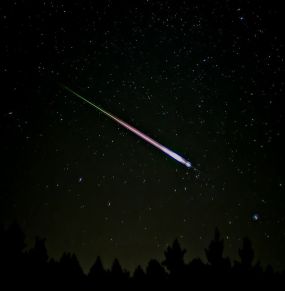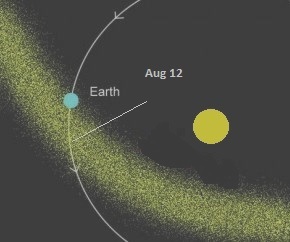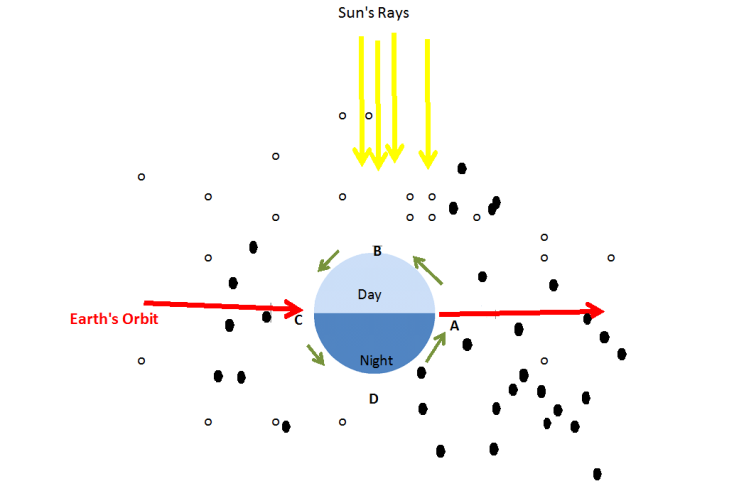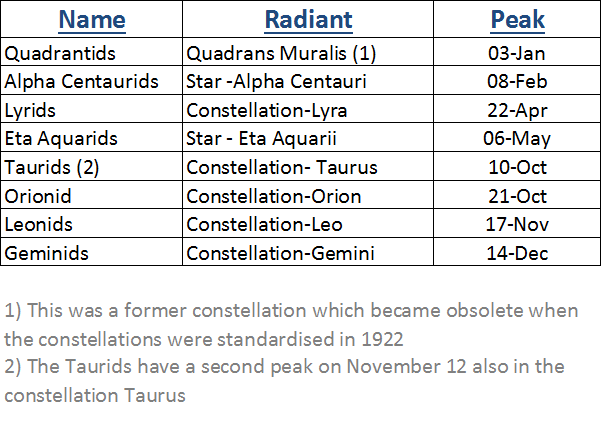For revised post containing more tips on how to view the Perseids see The Perseids 2021.
Anyone who is disappointed that they will be missing the total eclipse can console themselves with another astronomical event – providing that they live in the northern hemisphere, that the weather is favourable (no clouds, please) and that they can get away from populated areas with too much light pollution. This astronomical event is the Perseids, a meteor shower which appears at the same time every year, for reasons I’ll explain below.
Meteors, also known as shooting stars, are bright streaks of light lasting a few seconds. These are caused by small lumps of rock or metal called meteoroids hitting the Earth’s atmosphere at a very high speed (in the case of the Perseids around 200,000 km/h). As they pass through the atmosphere they get heated up by friction to a temperature of thousands of degrees and start to glow. This causes them to emit a streak of light as they pass through the Earth’s atmosphere. Most meteoroids get heated to such a high temperature that they vaporise and disappear from view.
Image from Wikimedia Commons
Most meteoroids are very small and are vaporised at an altitude of 50 km or higher. If the meteoroid is large enough, bigger than 1 cm in diameter, some of it can survive the passage through the Earth’s atmosphere and the part that hits the ground is known as a meteorite.
What causes the Perseids?
A comet called Swift-Tuttle orbits the Sun every 133 years. As it orbits the Sun it leaves a cloud of debris in its wake, where material has crumbled away from the surface. Over a long period of time all this material has formed a wide oval-shaped ring in the same orbit as the comet.
Once a year, and at the same time each year, the Earth passes through this ring of debris. When this happens some of the particles hit the Earth’s atmosphere. This is what causes the Perseids meteor shower. As you can see from the diagram the ring is fairly wide and is composed of an huge number of smaller particles. The Earth first crosses this ring in late July and takes until late August to get the other side. The thickest part of it is encountered around 12-13 August and this is the date on which the Perseid shower is at its most prolific.
When is the best time to observe the Perseids?
The best time of day to observe the Perseids, or in fact any meteor shower, is just before dawn. The diagram below shows the Earth passing through the debris cloud.
The diagram shows the Earth rotating on its axis. B indicates midday, when the Sun is highest in the sky, D midnight, A sunrise and C sunset.
In the hours after midnight (D to A), an observer is on the side of the Earth facing towards the Earth’s direction of travel, so there are far more meteoroids entering the Earth’s atmosphere. The time of day when the most meteoroids hit the earth is actually at dawn (A), but at that time the brightness of the early morning sky makes them difficult to see. The best time to see meteors is therefore just before it starts getting light in the morning.
If you have the chance to observe a meteor shower over a period of hours or even minutes, you will notice that if you follow the meteor trails backwards, all of them appear to originate from the same place. This is particularly noticeable if you take a long exposure photograph. The point in the sky from where the meteors appear to originate is called the radiant.
Image from Wikimedia Commons
The picture above shows a long exposure photograph of a meteor shower. The radiant is marked with a small circle. The Perseids’ radiant lies in the constellation Perseus, which is directly overhead around dawn at a latitude of 60 degrees North. My readers in the southern hemisphere won’t be able to see them, but you have your own meteor showers invisible to those of us up here!
The best way to observe the Perseids is to go a really dark place well away from light pollution and as I said previously the best time is in the early morning just before the sky starts getting light. In Manchester, where Mrs Geek and I live, the sunrise on 13 August is about 5:45 am and the best time to see the Perseids would be about three hours before this. Mrs Geek always tries to persuade me to get up in the middle of the night and drive into the countryside but, alas, I am too lazy. Another complicating factor is that the Moon rises at 11:15 pm on the night of 12 August and will be very bright, so the shower will be more difficult to view than in other years when we are at a different stage in the lunar cycle.
When astronomers measures the strength of a meteor shower, they use a term called the Zenithal Hourly Rate (ZHR). The ZHR is the maximum number of meteors an observer could see if the sky were completely dark, there were no cloud cover and the radiant were directly overhead. The diagram below shows how the ZHR varied with date for the Perseids last year.
(McCure 2016)
Fingers crossed for clear skies on the night of 12-13 August, but if we are unlucky, or if you are from down under, here’s a table showing some of the other showers, although none are on average as prolific as the Perseids:
References
McClure, B (2016) Perseid outburst expected in 2016, Available at:http://earthsky.org/astronomy-essentials/everything-you-need-to-know-perseid-meteor-shower (Accessed: 25 July 2016)







”
And thanks again for wake my internet site, where I bemoaned the last of my too-wet aspiration of jetting to America for 2 minutes of ‘darkness at high noon’. ”
And thanks again for wake my internet site, where I bemoaned the last of my too-wet aspiration of jetting to America for 2 minutes of ‘darkness at high noon’.
LikeLike
”
And thanks again for viewing my site, where I bemoaned the death of my too-wet dream of jetting to America for 2 minutes of ‘darkness at noon’. ”
And thanks again for viewing my site, where I bemoaned the death of my too-wet dream of jetting to America for 2 minutes of ‘darkness at noon’.
LikeLike
Nice post. I attempted a while back to explain the geometry of the Earth pushing its way into debris and making pre-dawn the best viewing time – but you did a better job of it! Nice diagram!
LikeLike
Thank you
The Science Geek
LikeLike
Correction: going belatedly through quite a few of the other posts here, I now, red-faced, see plenty of comment interaction.
Looking forward to your next post. (possibly soon after 21 Aug, by coincidence?)
LikeLiked by 1 person
Next post already written scheduled to go out on 12 August (I think) . Slight change of topic from my normal subject matter 🙂
LikeLike
Last year for the Perseids I journeyed down to the Negev desert, to one the the darkest places in our troubled part of the planet. With the Milky Way ‘s galactic splendor an almost orgasmic sight overhead, and the silence, (I was at the bottom of a natural depression, Mitzpeh Ramon) I didn’t even bother to count meteors; they flashed perhaps one per second,not because it was such a ‘good year’ , but because every space-dust particle down to the size of a skeeter’s belly-button lint was visible.
Oh, and the Moon was fortunately somewhere in hiding, resting up for his/her job of obscuring the Sun.
This experience taught me a valuable lesson: My exhausting-for-naught sleepless nights back home in my own backyard lawn chair when I count the ‘yep, that was a good one’ shooting stars on one hand in the groggy morning are a result not of dustless space, but of the unforgivable light pollution.
My advice of course for watchers is to ‘Come to Israel for the show.”
And thanks again for viewing my site, where I bemoaned the death of my too-wet dream of jetting to America for 2 minutes of ‘darkness at noon’.
Just now did a ‘back of-a restaurant-napkin’ calculation for the scene where the US population is equal-spaced camped out inside the path of totality: A gazer every 100 yards in each direction? Feel free to check my math, you are quite good at that/ JS
LikeLike
Thanks for your interesting comment. It soumds like you had a really good viewing last year. Lucky you !!
I too have been to the Negev Desert. Many years ago when I was on a family holiday to Eilat I went out into the desert by camel. An amazing experience
The Science Geek
LikeLike
Wow, ‘small world’…or ‘planet’.)Somehow I ‘felt’ that you’d likely been here at some point in time. ‘Don’t be a stranger’, as they say.)
I went that time with a mixed group of Arab and Jewish star-struck photographers. (A blessed friend of mine is almost single-hand-ededly working toward fostering dialogue between our camps, on a background of common interests. Like” “Me.. You… same galaxy? Let’s hug.”
Thrilled to read your prompt reply; in my perfect solar-system model, net-interaction looks like that.
Wondering privately how you feel, investing the obvious time and love in your careful posts… and all for 24 anonymous ‘Likes’. I’m assuming that you do have compensatory validation/feedback in your ‘day job.’
Still, I await a post here with “100 comments”, perhaps after you postulate a race of aliens thriving on the hidden ‘far side of the Moon’ Hey, if that’s the cost of gaining internet fame….
LikeLike
Let’s hope for fine weather, though the forecast isn’t all that wonderful!
LikeLike